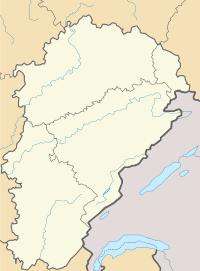Étueffont
From Wikipedia, the free encyclopedia
| Étueffont | |
|---|---|
 | |
 Étueffont | |
|
Location within Franche-Comté region  Étueffont | |
| Coordinates: 47°43′11″N 6°55′21″E / 47.7197°N 6.9225°ECoordinates: 47°43′11″N 6°55′21″E / 47.7197°N 6.9225°E | |
| Country | France |
| Region | Franche-Comté |
| Department | Territoire de Belfort |
| Arrondissement | Belfort |
| Canton | Rougemont-le-Château |
| Intercommunality | Pays sous Vosgien |
| Government | |
| • Mayor (2001–2008) | Gérard Guyon |
| Area | |
| • Land1 | 12.53 km2 (4.84 sq mi) |
| Population (2006) | |
| • Population2 | 1,552 |
| • Population2 Density | 120/km2 (320/sq mi) |
| INSEE/Postal code | 90041 / 90170 |
| Elevation | 399–915 m (1,309–3,002 ft) |
|
1 French Land Register data, which excludes lakes, ponds, glaciers > 1 km² (0.386 sq mi or 247 acres) and river estuaries. 2 Population without double counting: residents of multiple communes (e.g., students and military personnel) only counted once. | |
Étueffont is a commune in the Territoire de Belfort department in Franche-Comté in northeastern France.
History
The separate villages of Étueffont-Bas (founded in the 16th century, with 28 families in 1760) and Étueffont-Haut (founded in the 12th century, with 38 families in 1760) were merged into the current commune on 12 June 1973.
Geography
The town sits at the foot of the Vosges mountains on the banks of the Madeleine River, in the Regional Natural Park Les Ballons des Vosges.
Sights
In the village center an 18th-century smithy houses a Forge Museum[1] that commemorates four generations of blacksmiths working in the village from 1843 to 1977.
See also
References
- ↑ The Forge Museum website (French)
This article is issued from Wikipedia. The text is available under the Creative Commons Attribution/Share Alike; additional terms may apply for the media files.